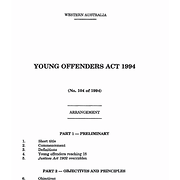
Young Offenders Act 1994, 11 January 1995, courtesy of State Law Publisher of Western Australia.
Details
The Young Offenders Act 1994 (104 of 1994) repealed sections of the Child Welfare Act 1947 relating to 'juvenile justice' (that is, the treatment of children and young people under the age of 18 who were charged with offences). The Act reflected the organisational changes that saw the responsibilty for children in detention move from the Department for Community Development to the Ministry of Justice.
The Young Offenders Act 1994 was assented to on 11 January 1995 and came into operation on 13 March of that year.
The Act (s.7) outlined some 'General principles of juvenile justice' as follows:
(a) there should be special provision to ensure the fair treatment of young persons who have, or are alleged to have, committed offences;
(b) a young person who commits an offence is to be dealt with, either formally or informally, in a way that encourages the young person to accept responsibility for his or her conduct;
(c) a young person who commits an offence is not to be treated more severely because of the offence than the person would have been treated if an adult;
(d) the community must be protected from illegal behaviour;
(e) victims of offences committed by young person should be given the opportunity to participate in the process of dealing with the offenders to the extent that the law provides for them, to do so;
(f) responsible adults should be encouraged to fulfil their responsibility for the care and supervision of young persons, and supported in their efforts to do so;
(g) consideration should be given, when dealing with a young person for an offence, to the possibility of taking measures other than judicial proceedings for the offence if the circumstances of the case and the background of the alleged offender make it appropriate to dispose of the matter in that way and it would not jeopardize the protection of the community to do so;
(h) detaining a young person in custody for an offence, whether before or after the person is found to have committed the offence, should only be used as a last resort and, if required, is only to be for as short a time as is necessary;
(i) detention of a young person in custody, if required, is to be in a facility that is suitable for a young person and at which the young person is not exposed to contact with any adult detained at the facility, although a young person who has reached the age of 16 years may be held in a prison for adults but is not to share living quarters with an adult prisoner;
(j) punishment of a young person for an offence should be designed so as to give the offender an opportunity to develop a sense of social responsibility and otherwise to develop in beneficial and socially acceptable ways;
(k) a young person who is dealt with for an offence should be dealt with in a time frame that is appropriate to the young person's sense of time;
(l) in dealing with a young person for an offence, the age, maturity, and cultural background of the offender are to be considered; and
(m) a young person who commits an offence is to be dealt with in a way that - (i) strengthens the family and family group of the young person; (ii) fosters the ability of families and family groups to develop their own means of dealing with offending by their young persons; and (iii) recognises the right of the young person to belong to a family.
When young people are sent to a detention centre, the Young Offenders Act 1994 is at the top of the hierarchy of five levels of rules that govern their custody, according to the OICS (2012, p.30). The Act is supported by the Young Offenders Regulations 1995. In addition, the Department of Corrective Services has developed three sets of rules which are, in 'rank order', Juvenile Custodial Rules, Standing Orders and Operational Procedures. These rules all derive their authority from the Act. However, as the Office of the Inspector of Custodial Services (OICS) has noted in inspection reports, there are a variety of practices in both rules and everyday operations that are inconsistent with the general principles of the Act.
Sources used to compile this entry: 'Western Australian Government Gazette No. 32', in Western Australian Government Gazette Online Archive, State Law Publisher of Western Australia, 10 March 1995, https://www.legislation.wa.gov.au/legislation/prod/gazettestore.nsf/FileURL/gg1995_032.pdf/$FILE/Gg1995_032.pdf; Buti, Tony, After the Removal, A submission by the Aboriginal Legal Service of WA (Inc) to the National Inquiry into Separation of Aboriginal and Torres Strait Islander Children from their Families., Aboriginal Legal Service of Western Australia (Inc), Perth, Western Australia, 1996. pp.342-351.; 'Report of an Announced Inspection of Banksia Juvenile Detention Centre : Report No.76, March 2012, p.vi, 30.', Reports and Publications, Office of the Inspector of Custodial Services, Perth, Western Australia, 2001, https://www.oics.wa.gov.au/reports-publications/.
Prepared by: Debra Rosser
Created: 2 May 2013, Last modified: 22 April 2016